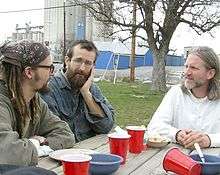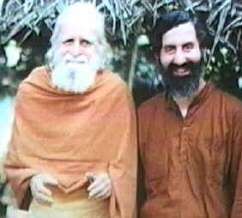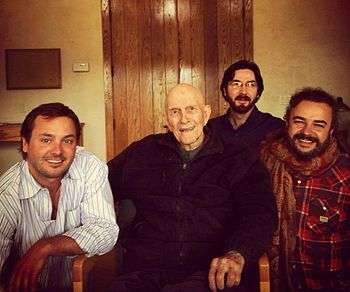New Monasticism
New Monasticism is a diverse movement, not limited to a specific religious denomination or church and including varying expressions of contemplative life. These include evangelical Christian communities such as "Simple Way Community" and Jonathan Wilson-Hartgrove's "Rutba House," European and Irish new monastic communities, such as that formed by Bernadette Flanagnal spiritual communities such as the "Community of the New Monastic Way" founded by feminist contemplative theologian Beverly Lanzetta, and "interspiritual" new monasticism, such as that developed by Rory McEntee and Adam Bucko. These communities expand upon traditional monastic wisdom, translating it into forms that can be lived out in contemporary lives "in the world."
Origins

The origin of the new monastic movement is difficult to pinpoint. Some communities now identified with new monasticism have been in existence since the 1970s and 80s in the UK. Other well-known communities, such as the Simple Way in Philadelphia, formed in the mid-90s.[1] Bede Griffiths, a Roman Catholic Camaldolese Benedictine monk who oversaw a Christian-Hindu ashram in India from 1968-1993, spoke often of the future of monasticism as being a '"lay movement"', and developed a vision for new monastic life.[2] Raimon Panikkar outlined the idea of a '"new monk"' in a series of lectures in 1980 given to a group of western and eastern monastics as well as non-monastic lay contemplatives at Holyoke, MA, which were subsequently published in the book Blessed Simplicity: The Monk as Universal Archetype.[3] In the early 1980s, contemplative feminist theologian Beverly Lanzetta started the '"Community of the New Monastic Way"', a non-denominational new monastic community still in existence today. Recently, various new monastic communities have appeared in Ireland and increasingly across the United States, including '"interspiritual"' new monastic communities, connected to the lineage of Bede Griffiths, such as that seen in the Foundation for New Monasticism.
Protestant forms of New Monasticism
The notion and terminology of Protestant "new monasticism" was developed by Jonathan Wilson in his 1998 book called Living Faithfully in a Fragmented World.[4] Wilson was, in turn, building on ideas of theologian Dietrich Bonhoeffer, who said in 1935: "the restoration of the church will surely come only from a new type of monasticism which has nothing in common with the old but a complete lack of compromise in a life lived in accordance with the Sermon on the Mount in the discipleship of Christ."[5] Wilson also built on ideas of philosopher Alasdair MacIntyre. Noting the decline of local community that could sustain the moral life, MacIntyre ended his book After Virtue, by voicing a longing for "another... St. Benedict."[6] By this, he meant someone in the present age to lead another renewal of morality and civility through community. Wilson identified with that longing in his own book, but outlined a vision to carry it forward within the Protestant Christian tradition.[7]
Calling the vision a "new monasticism", he proposed four characteristics that such a monasticism would entail: (1) it will be "marked by a recovery of the telos of this world" revealed in Jesus, and aimed at the healing of fragmentation, bringing the whole of life under the lordship of Christ; (2) it will be aimed at the "whole people of God" who live and work in all kinds of contexts, and not create a distinction between those with sacred and secular vocations; (3) it will be disciplined, not by a recovery of old monastic rules, but by the joyful discipline achieved by a small group of disciples practicing mutual exhortation, correction, and reconciliation; and (4) it will be "undergirded by deep theological reflection and commitment," by which the church may recover its life and witness in the world.[8]
The middle months of 2004 became a defining moment for the movement, when there was a gathering of a number of existing communities and academics in Durham, North Carolina, where they drew together something like a "rule of life," referred to as the "12 marks" of new monasticism.[9] The gathering took place at a new monastic community called "Rutba House," of which some founding members were Jonathan and Leah Wilson-Hartgrove. Not coincidentally, Leah Wilson-Hartgrove is the daughter of Jonathan Wilson whose writing has galvanized the movement.[10]
Common themes
Values
Most Protestant new monastic communities emphasize the following:
- Thoughtful, prayerful, and contemplative lives
- Communal life (expressed in a variety of ways depending on the community)
- A focus on hospitality
- Practical engagement with the poor
"Twelve Marks"
The "Twelve Marks" of new monasticism express the common thread of many new monastic communities.[11] These "marks" are:
- Relocation to the "abandoned places of Empire" [at the margins of society]
- Sharing economic resources with fellow community members and the needy among us
- Hospitality to the stranger
- Lament for racial divisions within the church and our communities combined with the active pursuit of a just reconciliation
- Humble submission to Christ’s body, the Church
- Intentional formation in the way of Christ and the rule of the community along the lines of the old novitiate
- Nurturing common life among members of an intentional community
- Support for celibate singles alongside monogamous married couples and their children
- Geographical proximity to community members who share a common rule of life
- Care for the plot of God’s earth given to us along with support of our local economies
- Peacemaking in the midst of violence and conflict resolution within communities along the lines of Matthew 18
- Commitment to a disciplined contemplative life
Differences from traditional Christian monasticism
The movement differs from other Christian monastic movements in many ways.
- Traditional monastic vows of celibacy, poverty, and obedience are not normally taken, as with members of traditional monastic orders, such as the Benedictines, Cistercians, Carthusians, and Basilians.
- Communities do not always live in a single place, but geographic proximity is emphasized by the movement.[12]
- The movement allows married couples. Most traditional forms of Christian religious life do not admit married couples. (Certain centuries-old Roman Catholic and more recent Anglican groups, known as "third," "secular," or "lay" orders, also admit married individuals who profess the spirituality of the order (including the Franciscans and Dominicans), but these are neither new nor monastic.) This, however, does not apply to much newer movements in the Catholic Church that accept married couples even into their core governance structures, of course. Check new communities such as Verbum Dei Missionary Fraternity, etc. Missionary married couples there profess spirituality of the community there too. And members do not wear any habits, either.
- Members of the movement do not wear religious habits. This contrasts with the long-established Roman Catholic third orders, whose members may wear some form of the religious habit of the order with which they are associated.
Other Forms of New Monasticism

Bede Griffiths
Catholic Camaldolese Benedictine monk Bede Griffiths spoke of monastic life being essentially a lay calling, and saw the future of monastic life in lay communities. "The monk is a lay person…An order of monastics is essentially a lay order. Some monks may live in monasteries, but increasingly the majority will live in their own homes or form small communities—a monastic order in the world."[13] He went on to express a new vision for monastics, one in which communities and individuals live spiritual lives independent of religious organizations or institutions, independent of celibacy and overarching rules and dogmas—free to follow their own conscience and guidance of the Holy Spirit in living a sacred life, yet united in the common cause of building a sacred world. A good summary of Fr. Bede’s thought on these matters is found in The New Creation in Christ.[2] Fr. Bede also wrote many other books on contemplative life, inter-religious experience and exploration, and the relationship between science and religion.
The "New Monk"
Raimon Panikkar explicated a vision of the "new monk" during a series of lectures given to western and eastern monastic from various religious traditions and lay contemplatives in 1980 at Holyoke, MA, these lectures were subsequently published as Blessed Simplicity: The Monk as Universal Archetype.[3] There Panikkar said the traditional monk is "only one way of realizing [this] universal archetype. … If the monastic dimension exists at least potentially in everybody, the institution of monasticism should be equally open to everybody. … The monastery, then, would not be the ‘establishment’ of the monks, but the schola Domini, the school where that human dimension is cultivated and transmitted. … Here appears the consequence of our distinction between the monk as archetype, i.e., the monk as a paradigm of religious life, against the archetype of the monk, i.e., the human archetype lived out by the monks, but which may also be experienced and lived today in different ways."[14]
The Community of the New Monastic Way
Beverly Lanzetta began a new monastic community in the early 1980s that was not associated with any particular religious tradition, "The Community of the New Monastic Way." Lanzetta speaks of the contemplative dimension of new monastic life as both proceeding and going beyond the religious traditions themselves. This is articulated in her books, Emerging Heart: Global Spirituality and the Sacred,[15] Path of the Heart and Radical Wisdom: A Feminist Mystical Theology.[16]
Interspiritual New Monasticism

Inspired by the new monastic forms of Bede Griffiths and Raimon Panikkar, and in partnership with Catholic monks Father Thomas Keating and Brother Wayne Teasdale, an "interspiritual" movement of new monasticism has formed around the work of young spiritual leaders and social activists in partnership with traditional monastics. This form of new monasticism is expressed and developed in Rory McEntee and Adam Bucko's The New Monasticism: An Interspiritual Manifesto for Contemplative Life.[17] Other collaborators include Episcopal priest Matthew Wright, Sufi lineage holder Pir Netanel Miles-Yepez, David and Tamara Milliken and their "InnerSky Community", V.K. Harber's work, and others.
Brother Wayne Teasdale coined the word "interspiritual," which he described in his books The Mystic Heart: Discovering a Universal Spirituality in the World’s Religions and A Monk in the World: Cultivating a Spiritual Life as a new orientation of religious and spiritual life with the following elements:[18][19]
- It will be an enhanced understanding of the inner life through assimilating the psychological, moral, aesthetic, spiritual, and literary treasures of the world’s religions. Each tradition will define itself in relation to every other viable tradition of the inner life; each will take into account the totality of the spiritual journey
- It is deeply concerned with the plight of all those who suffer, wherever they are…
- It follows a strict adherence to ecological justice …
- It doesn’t just depend on books or spiritual reading, but looks to art, music, and movies … universal languages of vast sacred potential … to nourish contemplative life…
- It recognizes that we are part of a much larger community … the human, the earth, the solar system, our galaxy, and the universe itself…
- Intermysticism [or interspirituality] is the deepest expression of the religious dimension of human life. It is the actual religion of each one of us when we arrive at the point of spiritual maturity.[20]
The Nine Vows of the New Monastic
In McEntee and Bucko's The New Monasticism: An Interspiritual Manifesto for Contemplative Life,[17] they describe the "Nine Vows of the New Monastic", which were based on Brother Wayne Teasdale's "Nine Elements of Spiritual Maturity"[21] and developed by the Rev. Diane Berke.
1. I vow to actualize and live according to my full moral and ethical capacity. 2. I vow to live in solidarity with the cosmos and all living beings. 3. I vow to live in deep nonviolence. 4. I vow to live in humility and to remember the many teachers and guides who assisted me on my spiritual path. 5. I vow to embrace a daily spiritual practice. 6. I vow to cultivate mature self-knowledge. 7. I vow to live a life of simplicity. 8. I vow to live a life of selfless service and compassionate action. 9. I vow to be a prophetic voice as I work for justice, compassion and world transformation.[22]
See also
- L'Arche
- Dorothy Day
- Catherine Doherty
- Jesuism
- Movement for a New Society
- Radical Orthodoxy
- Tolstoyan movement
- Catholic Worker Movement
References
- ↑ "the simple way" (website). Retrieved 2009-03-21.
- 1 2 Griffiths, Bede, The New Creation in Christ. Ed. by Robert Kiely and Laurence Freeman, OSB (Springfield: Templegate Publishers, 1994)
- 1 2 Panikkar, Raimon, Blessed Simplicity (New York: Seabury, 1982).
- ↑ Byassee, Jason. The Christian Century, "The New Monastics: Alternative Christian Communities", 24 April 2008.
- ↑ "The Northumbria Community" (website). Retrieved 2011-01-05.
- ↑ MacIntyre, Alasdair. After Virtue: A Study in Moral Theory (2nd ed.). Notre Dame, Indiana: University of Notre Dame Press. p. 263. ISBN 978-0-268-00610-5. OCLC 10751724. ISBN 0-268-00610-5. ISBN 0-268-00611-3. ISBN 978-0-268-00611-2.
- ↑ (Wilson 1998, p. 69)
- ↑ (Wilson 1998, pp. 72–75)
- ↑ Rob Moll, Christianity Today, "The New Monasticism", 24 April 2008.
- ↑ Divinity Online Edition - Fall 2005 Feature Article - The New Monasticism In Durham’s Walltown, a Covenant Community
- ↑ (Rutba House 2005, pp. xii-xiii)
- ↑ (Rutba House 2005, p. 124)
- ↑ Griffiths, Bede, The New Creation in Christ. Ed. by Robert Kiely and Laurence Freeman, OSB (Springfield: Templegate Publishers, 1994), 89
- ↑ Panikkar, Raimon, Blessed Simplicity: The Monk as Universal Archetype (New York: Seabury Press, 1982), 8, 20, 28
- ↑ Lanzetta, Beverly, Emerging Heart: Global Spirituality and the Sacred (Minneapolis: Fortress Press, 2007)
- ↑ Beverly Lanzetta, Radical Wisdom: A Feminist Mystical Theology (Minneapolis: Fortress Press, 2005)
- 1 2 McEntee, Rory and Bucko, Adam, The New Monasticism: An Interspiritual Manifesto for Contemplative Living, (Orbis Books: Maryknoll, 2015)
- ↑ Teasdale, Wayne. The Mystic Heart: Discovering a Universal Spirituality in the World’s Religions. Novato: New World Library, 1999.
- ↑ Teasdale, Wayne. A Monk in the World: Cultivating a Spiritual Life. Novato: New World Library, 2002.
- ↑ Wayne Teasdale, The Mystic Heart: Discovering a Universal Spirituality in the World’s Religions (Novato: New World Library, 1999), 238-243
- ↑ Wayne Teasdale, The Mystic Heart: Discovering a Universal Spirituality in the World’s Religions (Novato: New World Library, 1999)
- ↑ McEntee, Rory and Bucko, Adam, The New Monasticism: An Interspiritual Manifesto for Contemplative Living, (Orbis Books: Maryknoll, 2015), xxxv, xxxvi
Bibliography
- Mike Broadway and Isaac Villegas, "A New Monasticism", Radix vol. 31 no. 4 (2005): pp12–28.
Further reading
- McEntee, Rory; Bucko, Adam (2015). The New Monasticism: An Interspiritual Manifesto for Contemplative Living. Maryknoll: Orbis Books.
- Teasdale, Wayne (2002). A Monk in the World. Novato: New World Library.
- Cross, Simon (2010). Totally Devoted, the challenge of new monasticism. Authentic Media. ISBN 978-1-85078-868-3.
- Dekar, Paul R. (2008). Community of the Transfiguration: the journey of a new monastic community. New Monastic Library: resources for radical discipleship. Eugene, Oregon: Cascade Books. ISBN 978-1-55635-430-4.
- Stock, Jon R.; Otto, Tim; Wilson-Hartgrove, Jonathan (2007). Inhabiting the Church: biblical wisdom for a new monasticism. Eugene, OR: Cascade Books. ISBN 978-1-59752-990-7.
- Rutba House (2005). Schools for Conversion: 12 marks of a new monasticism. Eugene, OR: Cascade Books. ISBN 978-1-59752-055-3.
- Wilson-Hartgrove, Jonathan (2008). New Monasticism : what it has to say to today's church. Grand Rapids, Michigan: Brazos Press. ISBN 978-1-58743-224-8.
- Sine, Tom (2008). The New Conspirators: creating the future one mustard seed at a time. Downers Grove, Illinois: IVP Books. ISBN 978-0-8308-3384-9.
- Claiborne, Shane. The Irresistible Revolution: living as an ordinary radical. Grand Rapids, Michigan: Zondervan. ISBN 978-0-310-26630-3.
- Claiborne, Shane; Haw, Chris (2008). Jesus for president: politics for ordinary radicals. Grand Rapids, Michigan: Zondervan. ISBN 978-0-310-27842-9.
- Bessenecker, Scott A. (2006). The New Friars: the emerging movement serving the world's poor. Downers Grove, Illinois: IVP Books. ISBN 978-0-8308-3601-7.
- Freeman, Andy; Greig, Pete (2007). Punk Monk: new monasticism and the ancient art of breathing. Ventura, California: Regal Books. ISBN 978-0-8307-4368-1.
- Wilson, Jonathan R. (1998). Living Faithfully in a Fragmented World: lessons for the church from MacIntyre's "After Virtue". Harrisburg, PA: Trinity Press International. ISBN 978-1-56338-240-6.
- Zdero, Rad (2004). The Global House Church Movement. Pasadena: William Carey Library Publishers. ISBN 978-0-87808-374-9.
- Zdero, Rad (2007). NEXUS: The World House Church Movement Reader. Pasadena: William Carey Library Publishers. ISBN 978-0-87808-342-8.
- Zdero, Rad (2011). Letters to the House Church Movement: Real Letters, Real People, Real Issues. Xulon Press. ISBN 978-1-61379-022-9.
- Simpson, Ray Pilgrim Way: New Celtic Monasticism for Everyday People (2005) Kevin Mayhew Ltd ISBN 978-1844173204
- Simpson, Ray (2009). High Street Monasteries: Fresh Expressions of committed. Kevin Mayhew. ISBN 978-1-84867-168-3.
- Graham Cray, Ian Mobsby and Aaron Kennedy, Edited by (2010). New Monasticism as Fresh Expressions of Church. Canterbury Press. ISBN 978-1-84825-044-4.
External links
| Wikiquote has quotations related to: New Monasticism |